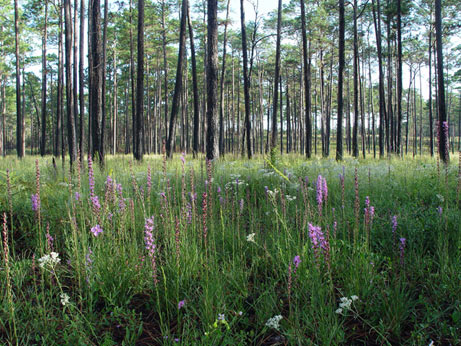and bring home the beauty of real Florida.
Visit FloridaNativeNurseries.org
 North Florida Sandhill community, photo by Nancy Bissett.
North Florida Sandhill community, photo by Nancy Bissett.Why Native Plant Communities are Important Models for Landscape Design
– by Michael Jameson, native plant grower and founding member of FANN
When children are nurtured and raised into adulthood, the ideal is that these people will then be able to take care of themselves and may provide benefit to local society and the world. Some benefits are easily recognizable, while others cannot be grasped by common perceptions. Each person is a member of the larger community and plays a part, whether as a president or as a janitor (the janitor could be the more important one). Each is especially important. Their presence and effect are undeniable, however minor they may seem.
A plant community is no different. There are plants that have pretty flowers and large trees that provide expanses of shade, some plants that provide nectar for bees and other plants that, well, I don’t know … The list goes on and on. Some plants may seem more important than others, but each provides some specific ingredient, provokes a reaction, and through their interaction with other community members, makes up a beautiful and complicated “painting” that we can refer to as a “plant community.”
Let’s take this one step further. As conscious as we can be of planting (together) components of a plant community, we must be equally thoughtful of where we plant. The plants making up a community that we refer to as a “fresh water wetland” will most likely not thrive on the top of dry hill, and most won’t live on a wind-blown salty beachfront.
If we can be more thoughtful of following nature’s guidelines, we will minimize the amount of energy, water and work needed to maintain our landscapes.
Some Definitions
A distinct and recurring assemblage of populations of plants, animals, fungi and microorganisms naturally associated with each other and their physical environment. – Florida Natural Areas Inventory
A group of native plants that interact with each other and their environment in ways not greatly altered by modern human activity or by introduced organisms
… form recognizable units [e.g., hardwood hammocks, pine flatwoods, beach dunes] that tend to repeat over space and time
… classified and described by considering vegetation, hydrology, landforms, soils and natural disturbance regimes [e.g., droughts, floods, storms and floods]
… named for the characteristic plant species within them or for characteristic environmental features [e.g., pine rockland].
– adapted from Minnesota Department of Natural Resources definition
Native plant communities are also referred to as natural communities, native or natural habitats, native plant associations. Generally, native plant communities are the “floral” components of natural ecosystems.
More than one classification system exists for Florida’s native plant communities. FANN uses one based on the 1967 Davis vegetation map.
References to Learn More
Florida Native Plant Society (FNPS), a statewide nonprofit with chapters in many counties, offers public field trips, programs and information about Florida’s native plant and native plant communities. FNPS is the oldest and largest organization of native plant enthusiasts, including gardeners and scientists, in the state.
Florida Natural Areas Inventory (FNAI), a nonprofit dedicated to developing and maintaing a database of Florida’s biological diversity. More detail and scientific information on our Florida native plant communities can be found online in FNAI’s Guide to the Natural Communities of Florida, 2010 Edition.